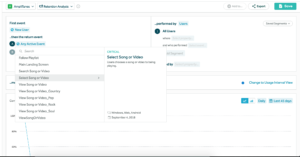I focus my writing on Consumer Products as those are the products I most often use. I’ve posted about platforms like the App Store – here and here, but it’s all been in the spirit about getting software to consumers.
But one of the best Products I’ve used over the last few months has been something I actually use for work! It’s called Amplitude and it’s a Product Analytics tool for Digital Products and Services. In my career as a Product Manager I’ve used lots of analytics software, but I never would have considered any a product I like to use, let alone something I would write about. So what makes Amplitude different?
Why Amplitude
Amplitude refers to itself as ‘Product Analytics for the Digital Era.’ Note how they don’t say ‘Digital Analytics’ or ‘Web/Mobile Analytics.’ From initial pitch to post-implementation, Amplitude was extremely clear on what their product is and who it’s for.
A Product for Product Managers
When they were pitching my company, they reached out to the product team and not to the analytics team. I’d never seen this before and it made sense when I had my initial call with them. They told me their software was designed to help Product Managers make quick, informed product decisions. Anecdotes about Product Managers having to wait a week for their analytics or data science teams to run analyses and complex queries really spoke to a pain point for me. Anyone in the organization could use Amplitude, but they knew whose problems they needed to solve in order get in the door.
Doing one thing really well
Amplitude acknowledged early on that they would not solve all of our organization’s analytics needs. In fact, they even told us that other clients use products other than Amplitude to report on key metrics. But what they promised was that they’d help track the metrics that are the leading indicators of Product Health. These are the metrics that Product Managers can influence through prioritization of their team’s work. And moving these metrics will ultimately influence lagging indicators of organization health, such as revenue.
This was quite refreshing as a customer. So often you see potential vendors promise to solve your every need, but this is never the case nor do you expect this to be case. And as a Product Manager myself I can appreciate a product team focused on a single user-persona and solving their most pressing needs.
User Experience
Consumer-facing products have upped the ante on user experience to the point where it impacts all product categories and Amplitude has definitely taken note! The experience of putting together a Weekly Retention Chart for New Users is very intuitive and easy with Amplitude. I’d go as far as to call it FUN!
Here’s how it works…
First, you pick ‘New User’ for First Event, then ‘Play Song’ for Returning Event and we get this pretty looking retention chart (from a sample Amplitude Project). And this particular one flattens out – a Product Manager’s dream!!!


But we don’t just want a pretty chart – you want something that helps you do your job better. As you can see, you can add definitions to your events and categorize them so everyone is on the same page. We’ve all been in situations where we misinterpret an event name and run an analysis that ends up being completely wrong.
Trust me, most Analytics companies don’t make charts that look this good or that are as easy to understand. Amplitude understands how user-experience differentiates its Product from others.
Giving Your Users a Super-Power
A framework I like to use to evaluate a product’s usefulness it to think about the ‘Super-Powers’ it gives its customers. So it’s asking yourself ‘What is that amazing thing my Product enables a customer to do?‘ Data is definitely something that Amplitude provides, but what it really excels at is providing Product Managers a framework for using that data. Two of the most useful frameworks I’ve gotten from Amplitude are Retention and North Star Metric.
Retention
As Product Managers we like to look at how many customers we have (DAUs, MAUs) and how many actions they perform (Audio/Video Stream, Social Posts), but these alone don’t tell us if we’ve created an enduring product. Amplitude – through their product, collateral and training – constantly pushes that retention is critical for true product growth. Does your Product provide value to the customer such that they repeatedly come back to and engage with it? If this is the case, you have found Product/Market Fit! DAU and MAU growth will prove illusory if you just have new users that never come back to experience the core Product value. Viewing our Products through the lens of Retention make you think hard about whether your product has true value and if the features you’re adding are actually valuable.
North Star Metric
What are you and your team building towards? Is it the right thing and how do you know when you’ve reached your goal? Amplitude’s North Star Metric is a great framework for setting priorities and keeping your team headed in the right direction. A great North Star Metric consists of 2 parts:
1) A Statement of Your Product Vision and
2) A Metric that Serves as a Key Measure of Your Product Strategy
As an example, Amplitude’s Product Vision is to ‘Help companies build better products‘ and their North Star Metric is the # of Weekly Users for whom Amplitude has answered at least one question.
A North Star Metric should also align to customer value – so avoid things like DAUs and instead focusing on the actions that drive value. Defining a good North Star Metric will then align your team and company on the right things. And as Product Manager you can use it to force prioritization on all the requests you get from Management and Stakeholders. You have the ‘Super-Power’ of being able to articulate your Product’s North Star and this will bring credibility to you and your team.
Creating Better Product Managers
Amplitude’s vision is to ‘Help Companies Build Better Products’ and in doing so they are also creating better Product Managers. Observing how they’ve acquired, engaged and retained customers themselves, Amplitude has given us a great example of how a Product-led Company operates.